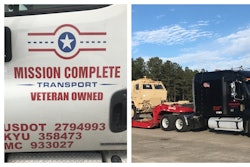Synthetic Service
Changing transmission and axle lubes at recommended intervals will guarantee long life and extend your warranty
By John Baxter
Transmission and axle lubricants don’t get dirty as fast as engine oil, but they are subject to heat and mechanical stress and have additives that eventually need to be replenished. They also gradually accumulate contaminants in the form of wear metals.
“We service our rear differentials and transmissions at 250,000-mile intervals and always use synthetic fluid, usually the same brand and grade that came new in the truck,” says small fleet owner Tom Meunier. “We do not service them ourselves but usually have them serviced at our dealer.”
We visited Ransome International in Swedesboro, N.J., to witness a transmission and axle lubricant change. We thank Brian Walsh, parts and service manager, and Paul Davis, technician first class, as well as Dan Arcy of Shell Lubricants for their assistance.
1. Park the vehicle on a hard, level surface and chock the wheels to make sure it will not roll. Place a container with a capacity of at least 30 quarts under the rearward rear axle.
2. Put a wrench into the square hole in the drain plug and turn it counter-clockwise to loosen the plug. Once loose, the plug may be removed by hand.
3. Carefully look at the drain plug, which is magnetic, to see what kinds of metal filings may have stuck to it. A thin, grainy film is okay, but large pieces of metal are a potential sign of trouble.

4. Wipe the plug and the threads inside the drain hole with a clean rag. Carefully screw in the plug straight, being careful not to crossthread it. It may help to turn the plug backward first till the threads catch, then gently turn it clockwise until it seats. Install the wrench and turn until just snug.
5. Wipe off the area around the filler plug, then remove it with a wrench. Feel around the hole with your fingers for any metal that may have accumulated, a great way to check for signs of internal trouble.
6. Fill the differential with the recommended lube, in this case a fully synthetic 75W-90 EP (for “Extreme Pressure”) lubricant. With the serial number of the vehicle, your dealer can provide information about the correct lube and how much lube will be needed, 50-64 pints in this case. Check with your finger to make sure the liquid level is right at the bottom of the hole even when liquid is dripping out. Then reinstall and torque the filler plug. Inspect the drain plug for leaks now that the unit is full.
7. Once the rear drive axle has been changed, repeat the entire process on the forward drive axle. This is identical except that it may hold a little more fluid because the inter-axle differential is mounted on top.
8. Empty your drain pan and place it under the transmission, which is bolted to the rear of the engine. Find the drain plug on the transmission and remove it, ensuring you pull the plug at the lowest point so all the fluid will drain out.
9. As with the axles, clean the plug and look for large metal filings before reinstalling. Clean the area around the fill plug, with is located on the side of the transmission
10. Fill with about 22 pints in this case of the recommended fluid, a fully synthetic 50-weight transmission fluid..
11. When finished, drive the truck a short distance and return to your workplace. Inspect both the drive axles and the transmission again for leaks.
BIG RIGS BASIC TIP
Paul Davis, technician first class for Ransome International, had a tip for better care of transmissions and axles: Have oil analysis done on the lubes you drain out. Just after removing the drain plug for the component, put the sample bottle under the stream of liquid and catch enough to fill it to the line on the side. Fill out the label with all required information. Oil analysis will reveal developing problems and reduce the cost of repairs.
WHY SHOULD I USE SYNTHETIC LUBE?
“Synthetics offer both superior low temperature performance and a high level of film strength at high temperatures to better protect all moving parts,” says Dan Arcy, OEM technical manager at Shell Lubricants. This means the fluid will be thin enough to flow easily and quickly reach all the parts when you start up on a cold morning, yet will remain more than thick enough when running at high speeds on a hot day to keep the parts from touching one another.
Component makers believe the extra protection synthetics give is necessary because they now offer extended warranties — typically up to 750,000 miles. The extra protection keeps you from having trouble — and them from having to pay warranty claims. You can typically keep the warranty in effect if you change the fluid, using an approved lube as the replacement, at 500,000 miles.
While synthetic lubes cost about 2.5 times what mineral lubes cost, don’t be fooled by the price. To reach a million miles, you’ll replace a synthetic lube only once, while you’d replace a mineral lube eight times.
Note the critical difference between transmission and axle lubes, and make sure you install the right one in each component. The two viscosity scales are different to help you tell the two lubes apart.








